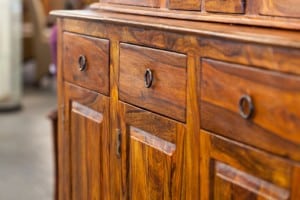 No matter what kind of facility you run, your furniture makes an impression on visitors and staff. If you have wood furniture in your waiting room, office, or school, it’s likely that you made quite an investment. Today, we’ll talk about:
No matter what kind of facility you run, your furniture makes an impression on visitors and staff. If you have wood furniture in your waiting room, office, or school, it’s likely that you made quite an investment. Today, we’ll talk about:
- How to maintain your furniture
- How to remove blemishes you already have
- The best way to care for your wood furniture
Follow the tips below, and your furniture will look beautiful for years to come.
Preventative Care
As is always the case with cleaning our spaces, the best thing you can do for your wood is preventative maintenance. Ensure that you have the tools and resources available for employees and customers to clean up spills and messes as soon as they happen.
This may mean keeping paper towels or cotton rags nearby, or having a designated person patrol certain areas, such as waiting rooms, every hour or so. Always keep coasters available or cover your table with a protective tablecloth to prevent rings from condensation, spills, and other mishaps.
Regularly dusting of your wood will prevent the buildup of grime over time that can eventually cause permanent damage to the wood. Use a dry, gentle duster such as Worldwide Janitor’s Lambswool Duster on a regular basis (at least once a week) to keep dust off of your furniture’s surface. There’s no need to use polish every time you clean. We’ll talk about using polish on your furniture below.
Keep Furniture Out of Heat and Light
The biggest enemies of your wood furniture are heat and light. Keeping your furniture in a dim or dark area away from direct sunlight and heating vents is key to ensuring that your furniture has a long life. If it’s not possible to move your furniture to a new place away from harmful light rays, consider investing in high-quality, heavy curtains to keep the sunlight out during bright times of the day.
Keep Moisture Away
As a general rule, it’s best to keep moisture away from your wood furniture unless you need to use it to remove messes. If liquid is spilled on your wood surface, mop it up immediately to reduce the risk of leaving unsightly marks.
Removing Spots and Blemishes
If you already have blemishes on your wood, there are ways to get rid of them or diminish their appearance. However, if you have a piece of antique furniture, it may have shellac or varnish on it that could be damaged during the stain removal process. If you’re not sure, you may want to speak with a furniture professional before proceeding. You can also test the following method on an inconspicuous portion of the furniture to ensure that it won’t do damage.
To get rid of rings from glasses used on your tabletop, create a paste by combining baking soda and water. Buff the resulting solution onto the affected area gently in a circular motion and remove what’s left with a slightly damp cloth.
If your furniture has a hazy finish from either too much polishing or a hot dish or pizza box, put a small amount of vegetable oil onto a paper towel and buff the surface gently in a circular motion to remove the haze.
To Polish or Not to Polish?
Contrary to common practice, not all furniture needs to be polished. Polishing depends on whether or not your furniture is finished.
If you’re not sure whether or not your furniture is finished, here’s how to find out: put a small droplet of water on an inconspicuous area of the wood. If it absorbs and leaves a small temporary mark, the piece is unfinished. If it remains on the surface as a water droplet, your furniture is finished.
If your wood furniture is unfinished, clean up messes using a damp cloth. You can also spray on a solution consisting of half water and half white vinegar. Never use cleaning products that are not especially designated for wood products. These include general purpose cleaners, ammonia, or bleach.
If your wood is finished, use a quality wood finishing product such as Worldwide Janitor’s Cream Furniture Polish or Lemon Oil Furniture Polish. Doing so will help protect your wood from heat and regular use. Using too much polish or polishing too often will attract dust and could create a haze on your furniture. Be sure to polish only when you see that your furniture is looking dull or uneven, and start with a small amount of polish if you’re unsure of how much is needed.
By taking these steps, you can make a great impression on everyone who uses your facility. Integrate regular preventative maintenance into your cleaning routine, provide protection, and apply polish when necessary to keep your furniture looking like new.
What steps do you take to clean and polish your wood furniture?





